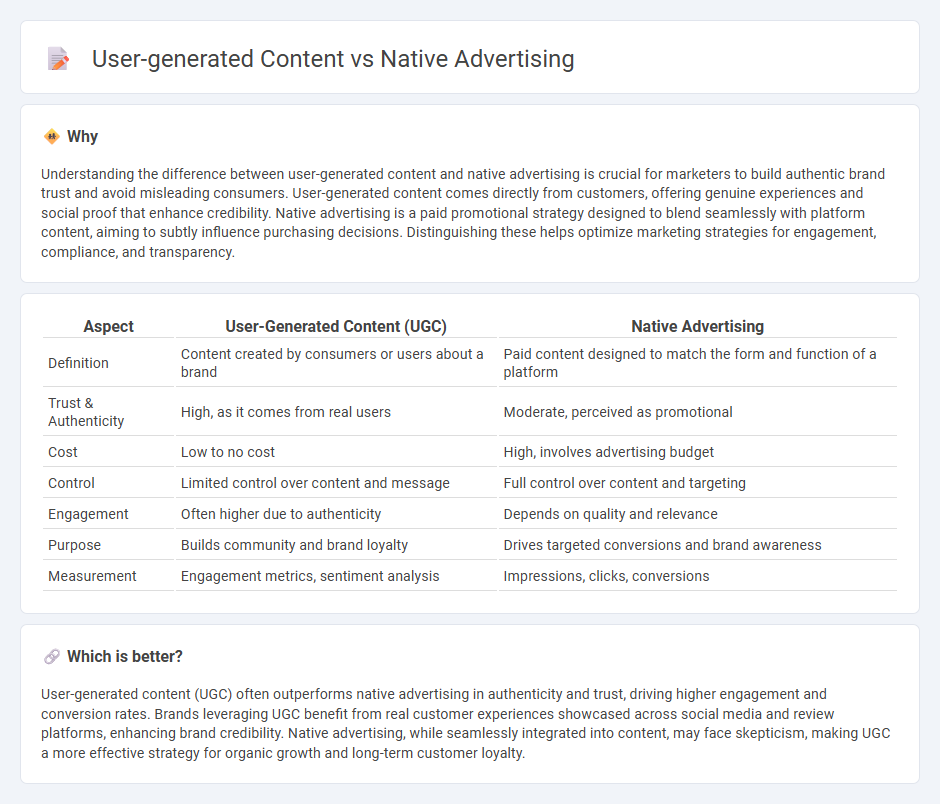
User-generated content (UGC) harnesses authentic consumer experiences and social proof to build brand trust and engagement, often outperforming traditional ads in credibility. Native advertising seamlessly integrates promotional messages within relevant content, enhancing user experience without disrupting the audience's consumption flow. Explore the distinct advantages and strategies of UGC versus native advertising to optimize your marketing efforts.
Why it is important
Understanding the difference between user-generated content and native advertising is crucial for marketers to build authentic brand trust and avoid misleading consumers. User-generated content comes directly from customers, offering genuine experiences and social proof that enhance credibility. Native advertising is a paid promotional strategy designed to blend seamlessly with platform content, aiming to subtly influence purchasing decisions. Distinguishing these helps optimize marketing strategies for engagement, compliance, and transparency.
Comparison Table
| Aspect | User-Generated Content (UGC) | Native Advertising |
|---|---|---|
| Definition | Content created by consumers or users about a brand | Paid content designed to match the form and function of a platform |
| Trust & Authenticity | High, as it comes from real users | Moderate, perceived as promotional |
| Cost | Low to no cost | High, involves advertising budget |
| Control | Limited control over content and message | Full control over content and targeting |
| Engagement | Often higher due to authenticity | Depends on quality and relevance |
| Purpose | Builds community and brand loyalty | Drives targeted conversions and brand awareness |
| Measurement | Engagement metrics, sentiment analysis | Impressions, clicks, conversions |
Which is better?
User-generated content (UGC) often outperforms native advertising in authenticity and trust, driving higher engagement and conversion rates. Brands leveraging UGC benefit from real customer experiences showcased across social media and review platforms, enhancing brand credibility. Native advertising, while seamlessly integrated into content, may face skepticism, making UGC a more effective strategy for organic growth and long-term customer loyalty.
Connection
User-generated content (UGC) enhances native advertising by providing authentic, relatable material that seamlessly blends with platform content, increasing audience trust and engagement. Native ads incorporating UGC leverage real customer experiences and reviews, boosting credibility and driving higher conversion rates. This synergy enables marketers to create more effective campaigns that resonate with consumers and improve overall brand perception.
Key Terms
Sponsored Content
Sponsored content blends seamlessly with editorial material, enhancing brand visibility without disrupting user experience. Unlike user-generated content, which relies on authentic consumer contributions, sponsored content is strategically crafted to align with brand messaging and target audience preferences. Explore how integrating sponsored content can elevate your marketing strategy by visiting our detailed guide.
Authenticity
Native advertising integrates seamlessly with editorial content, enhancing brand visibility without disrupting user experience, while user-generated content (UGC) brings genuine consumer voices and authentic engagement. Both strategies prioritize authenticity by fostering trust, yet UGC often drives deeper emotional connections through real customer stories and organic interactions. Explore our detailed analysis to understand how authenticity shapes marketing success in native advertising versus user-generated content.
Brand Engagement
Native advertising seamlessly integrates promotional content within a platform's organic environment, enhancing brand engagement by maintaining user experience while subtly influencing audience perception. User-generated content (UGC) boosts brand authenticity and trust, driving higher engagement rates through personalized and relatable consumer narratives. Explore how leveraging both strategies can optimize your brand's interaction and loyalty.
Source and External Links
What is Native Advertising - How it Works - Outbrain - Native advertising is paid content designed to match the look, feel, and function of the media format where it appears, helping brands engage audiences on leading publisher sites through non-disruptive, relevant content.
The Good, the Bad, and the Ugly of Native Advertising - Clearcode - Native ads blend in with a website's organic content in both form and function, making them more effective at capturing attention and driving engagement compared to traditional banner ads.
Native Advertising: How It Works, Types, Benefits - Taboola.com - Native advertising works by seamlessly integrating paid content into the platform's editorial flow, making it a versatile and effective strategy for nearly any business seeking to reach targeted audiences without disrupting the user experience.
 dowidth.com
dowidth.com